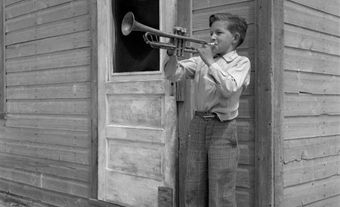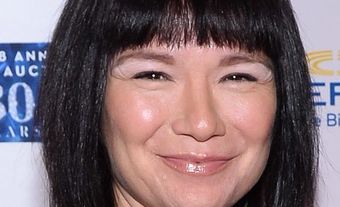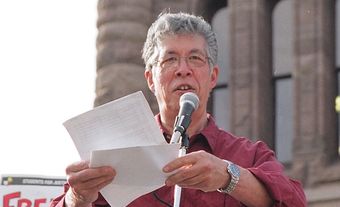Music entertains and soothes, but it can also educate and challenge. These talented artists are among many popular Indigenous musicians in Canada. Their work celebrates Indigenous cultures and shines a light on important issues concerning Indigenous people in Canada.
1. The Halluci Nation (A Tribe Called Red) (established in 2007)
The Halluci Nation, formerly known as A Tribe Called Red, is an electronic group famous for their powwow drum-based dance music. Beginning in 2007 as Electric Pow Wow, The Halluci Nation has been described as one of the musical groups representing what Wab Kinew called the “Indigenous Music Renaissance.” Since its inception, The Halluci Nation has won numerous awards, including the Juno Award for Breakthrough Group of the Year in 2014 and 2018. Much of The Halluci Nations music is politically inspired, and they have collaborated with prominent musicians and artists including John Trudell and Tanya Tagaq.

2. Willie Dunn (born 14 August 1941; died 5 August 2013; Mi'kmaq)
Willie Dunn performed at folk festivals in the 1960s and 1970s with his compositions speaking to Indigenous cultures and concerns. Dunn recorded six albums and wrote music for radio, television, and movies. His most popular song was I Pity the Country, a devastating portrait of colonialism and the price paid by Indigenous peoples.
In 1968, Dunn became the National Film Board’s first Indigenous director with the release of The Ballad of Crowfoot. He went on to direct two more NFB films: These Are My People and The Other Side of the Ledger: An Indian View of the Hudson’s Bay Company.
3. Robbie Robertson (born 5 July 1943; Kanyen'kehà:ka (Mohawk))
When still a teenager, Robbie Robertson toured as part of rock ‘n’ roll legend Ronnie Hawkins’ band, the Hawks. In 1968, the Hawks became The Band with Robertson as its lead guitarist and primary songwriter. He composed many hit songs including The Weight, The Night They Drove Old Dixie Down, and Up on Cripple Creek. Robertson also became a respected session guitarist and producer.
After The Band broke up in 1976, Robertson composed music for movies. His recordings, such as the album Music for the Native Americans and songs like Showdown at Big Sky and Somewhere Down the Crazy River explored Indigenous themes.

4. Tom Jackson (born 27 October 1948; Métis)
In the 1960s and 1970s, Tom Jackson’s rich baritone entertained audiences at coffee houses and festivals across Canada. His original songs explored a range of interests that included Indigenous concerns. His first of over a dozen successful country-rock albums, No Regrets, was released in 1994. Jackson also became a successful playwright and actor.
He used his music for social activism; bringing attention to hunger, poverty, and mental health. Beginning in 1988, his annual Huron Carole Benefit Concert Series Christmas Tour took artists from coast to coast to raise money for various issues. His Dreamcatcher Tour brought attention to suicides among Indigenous youth.

5. Susan Aglukark (born 27 October 1967; Inuk)
Susan Aglukark’s 1995 album, This Child, contained the song, O Siem, which became the first international hit by an Inuit performer. She believed deeply in the effectiveness of the arts in promoting and protecting Indigenous cultures. Aglukark recorded a number of albums and enjoyed more hit songs that blended Indigenous and traditional pop themes, including Hina Na Ho.
Her political activism includes a public statement at a 2018 hearing for Missing and Murdered Indigenous Women and Girls where Aglukark identified the man who sexually abused her as a child. She also was a co-founder of the Aboriginal Literacy Initiative and created the Arctic Rose Fund to combat hunger in northern communities. (See also Country Food (Inuit Food) in Canada.)

6. Tanya Tagaq (born 5 May 1975; Inuk)
Tanya Tagaq is a residential school survivor who, in her early 20s, heard recordings of Inuit throat singing. Her debut album, Sinaa, released in 2005,blended throat singing with western electronic, rock and punk music. The album’s success earned her a Canadian Aboriginal Music Award (now Indigenous Music Award) as the Best Female Artist.
Tagaq went on to release more successful albums, including Animism which won the Polaris Music Prize in 2014. She also performed across Canada and the United States, helped create documentary films, and published a novel, Split Tooth (2018). Her collaborations and work with musicians as diverse as Canadian rapper Shad, Icelandic singer-writer Björk, and the Winnipeg Symphony Orchestra, afforded her and Inuit music international recognition.

7. Jeremy Dutcher (born 8 November 1990; Wolastoqiyik, Tobique First Nation)
Jeremy Dutcher is a composer, singer, and musicologist, dedicated to protecting and celebrating Wolastoqiyik music and its language. In 2018, his album, Wolastoqiyik Lintuwakonawa, blended old wax recordings of Wolastoqiyik music with Dutcher’s new compositions, all sung in the Wolastoqiyik language. It won the Polaris Music Prize and a Juno Award.
With only about 100 people still fluent in the Wolastoqiyik language, Dutcher believes it is crucial to use music once banned by the government to preserve memory and promote a message of what remains vital to the next generation. (See also Indigenous Languages in Canada.)
8. Leela Gilday (born 1974; Dene)
Leela Gilday grew up in Yellowknife and earned a Bachelor of Music degree from the University of Alberta in 1997. Her compositions speak of her love of the north and its rugged environment and the resilience of those who call it home. For over 20 years she and her band have toured Canada and much of the world where audiences have become enthralled with her powerful voice and soulful performances. Her numerous albums blend Dene traditions and language with contemporary western pop and blues. In 2021, Gilday won a Juno award as Indigenous Artist of the Year.
9. Charlie Panigoniak (born 7 March 1946; died 6 March 2019; Inuk)
Sometimes referred to as “Johnny Cash of the North,” Charlie Panigoniak was the first person to record music in Inuktitut. Panigoniak wrote music in a country- folk style and released two EPs and three LPs through the CBC’s Northern Service. Additionally, he made two broadcast EPs with CBC. In addition to his music, Panigoniak also worked as a broadcaster for CBC Radio in Rankin Inlet. He received the Commissioner’s Performing Arts Award from the Nunavut territorial government and was made a Member of the Order of Nunavut.
10. Kashtin (established in 1984; Innu)
Kashtin is an Innu country and folk group made up of Florent Vollant and Claude McKenzie. Their debut album, Kashtin, received Félix awards for best debut and best country-folk album. Many of Kashtin’s songs are sung in Innu-aimun (the Innu language). Their song “Tshinanu” is considered an Innu anthem. In addition to their Félix awards, Kashin’s albums have also been nominated for Juno Awards, including a nomination for Best Roots & Traditional Album for the 1991 album Innu.


 Share on Facebook
Share on Facebook Share on X
Share on X Share by Email
Share by Email Share on Google Classroom
Share on Google Classroom







